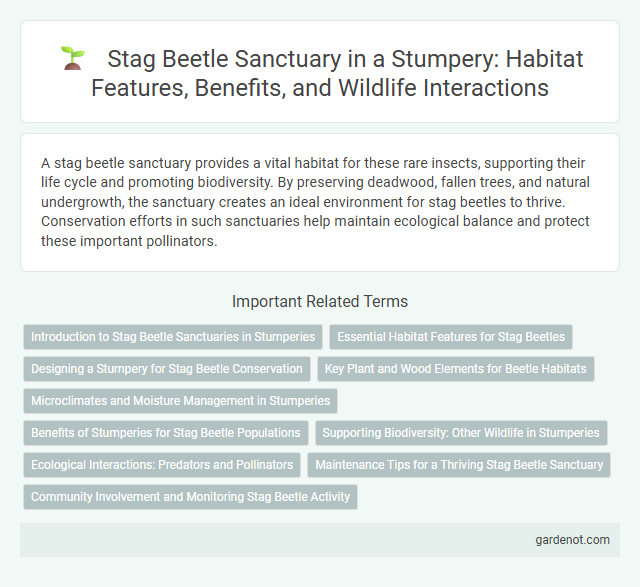A stag beetle sanctuary provides a vital habitat for these rare insects, supporting their life cycle and promoting biodiversity. By preserving deadwood, fallen trees, and natural undergrowth, the sanctuary creates an ideal environment for stag beetles to thrive. Conservation efforts in such sanctuaries help maintain ecological balance and protect these important pollinators.
Introduction to Stag Beetle Sanctuaries in Stumperies
Stag beetle sanctuaries within stumperies provide essential habitats for these rare insects, supporting their life cycles by preserving decaying wood and soil conditions. These sanctuaries mimic natural forest environments, promoting biodiversity and aiding conservation efforts for Lucanus cervus, the largest beetle species in Europe. Maintaining stag beetle populations in stumperies contributes to ecological balance and enhances awareness of woodland invertebrate habitats.
Essential Habitat Features for Stag Beetles
Stag beetle sanctuaries prioritize essential habitat features like decaying wood, which serves as critical breeding and larval development sites. Maintaining diverse deadwood types, including fallen trees and rotting stumps, supports the stag beetle's life cycle and enhances biodiversity. These sanctuaries also ensure soil moisture retention and undisturbed ground conditions to create optimal environments for stag beetle larvae.
Designing a Stumpery for Stag Beetle Conservation
Designing a stumpery for stag beetle conservation involves creating a habitat rich in decaying wood, which provides essential breeding and feeding sites for this endangered species. Incorporate a variety of hardwood branches and logs arranged in shaded, damp areas to mimic natural forest floor conditions that support larval development. Strategic placement of stumps and leaf litter enhances microhabitats, increasing shelter and moisture retention critical for stag beetle survival.
Key Plant and Wood Elements for Beetle Habitats
Stag beetle sanctuaries thrive with key plant species such as oak, beech, and hazel, which provide essential decaying wood for larvae development. Fallen logs, deadwood piles, and stumperies composed of rotting branches create crucial microhabitats that maintain moisture and shelter for adult beetles. Incorporating native plants and preserving alder and willow trees enhances the biodiversity and stability of beetle habitats within these sanctuaries.
Microclimates and Moisture Management in Stumperies
Stumperies create ideal microclimates for stag beetle sanctuaries by providing shaded, humid environments essential for larval development. The decaying wood and dense planting retain moisture, preventing soil desiccation and supporting fungal growth critical to stag beetle life cycles. Effective moisture management through mulching and natural debris layers maintains stable humidity levels vital for stag beetle habitat sustainability.
Benefits of Stumperies for Stag Beetle Populations
Stumperies provide essential habitats by offering decaying wood that supports the lifecycle of stag beetle larvae, promoting successful reproduction and population growth. These structures enhance biodiversity by attracting various invertebrates and fungi, creating a balanced ecosystem beneficial to stag beetles. Conserving natural woodlands through stumperies aids in mitigating habitat loss, ensuring long-term sustainability for stag beetle populations.
Supporting Biodiversity: Other Wildlife in Stumperies
Stumperies provide essential microhabitats that support stag beetles and a variety of other wildlife including amphibians, birds, and small mammals by offering shelter and fostering a rich insect population. The decaying wood creates a nutrient-rich environment that promotes fungi and moss growth, crucial for maintaining ecosystem diversity. These structures enhance biodiversity by mimicking natural woodland conditions, encouraging species interactions and ecosystem resilience.
Ecological Interactions: Predators and Pollinators
Stag beetle sanctuaries provide critical habitats that support diverse ecological interactions, including natural predators like birds and mammals that regulate beetle populations. These sanctuaries also foster pollinator activity, as stag beetles contribute to nutrient cycling by breaking down decaying wood, indirectly aiding flowering plant pollination. Maintaining such ecosystems enhances biodiversity and promotes balanced predator-prey dynamics essential for forest health.
Maintenance Tips for a Thriving Stag Beetle Sanctuary
Regularly monitor decaying wood quality and moisture levels to maintain an ideal habitat for stag beetles, ensuring they have ample breeding and feeding sites. Remove invasive plant species and avoid excessive disturbance to preserve the microhabitat's stability. Providing a mix of deadwood types and securing shaded, damp areas supports stag beetle larval development and adult emergence.
Community Involvement and Monitoring Stag Beetle Activity
Community involvement is crucial for the Stag Beetle sanctuary, engaging local volunteers in habitat preservation and public education to support the species' survival. Regular monitoring of stag beetle activity involves systematic surveys and data collection, helping track population trends and identify key habitats for conservation efforts. Collaborative efforts between researchers and residents enhance the effectiveness of protection measures, fostering a sustainable environment for stag beetles.
Stag beetle sanctuary Infographic

 gardenot.com
gardenot.com